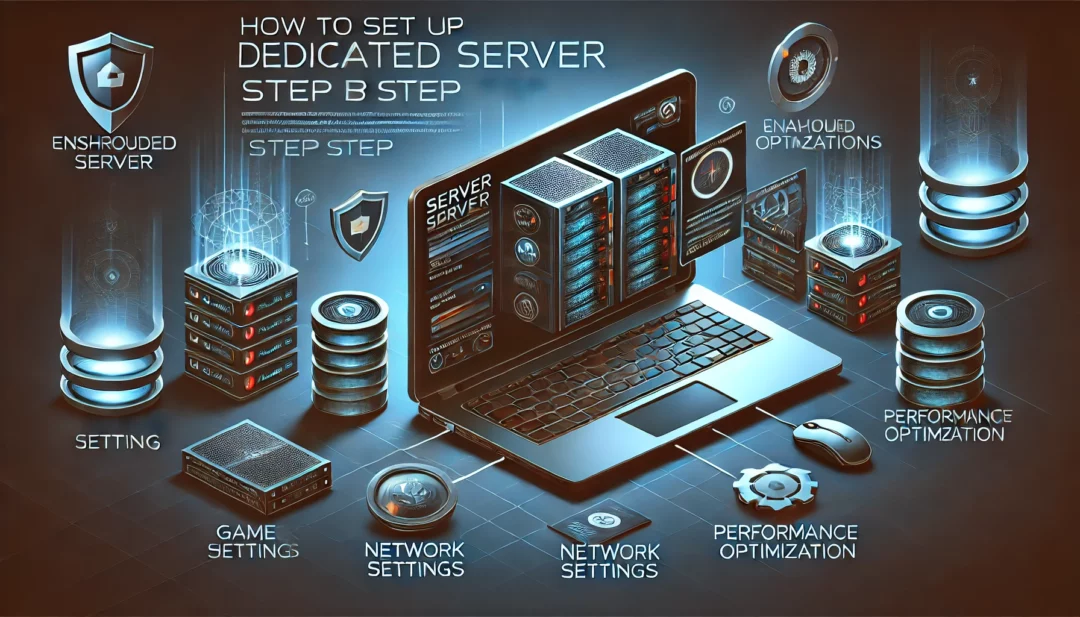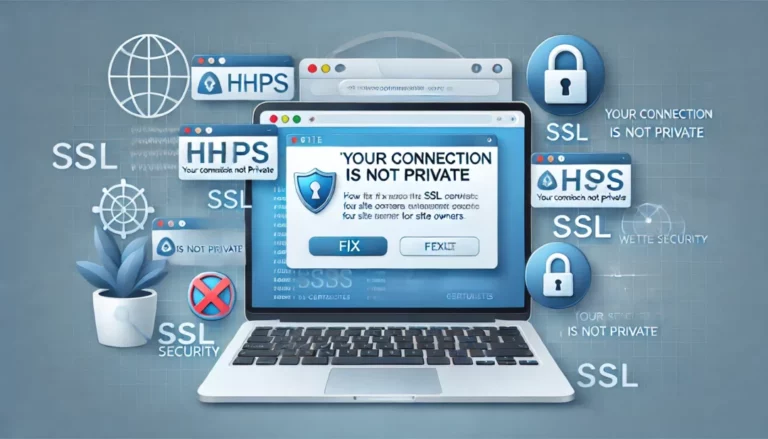
Setting up an Enshrouded dedicated server might seem complex, but it’s a straightforward process when broken into clear steps. Whether you’re hosting a game server or managing a private workspace, having your own dedicated server gives you control, flexibility, and reliability. With the right approach, you’ll have it up and running in no time.
You’ll start by choosing the right hosting provider and configuring your server’s hardware and software specifications. Then, install the necessary operating system and secure the server with essential protections. Finally, optimize your settings and test the setup to ensure everything runs smoothly. By following these steps, you’ll create a stable and efficient server environment tailored to your needs.
Understanding An Enshrouded Dedicated Server
An Enshrouded dedicated server provides customized, secure hosting environments for private or business applications. It’s specifically managed to maintain data privacy and service reliability.
What Is An Enshrouded Dedicated Server?
An Enshrouded dedicated server is a physical server rented exclusively to a single client with advanced privacy features and isolated resources. It operates in a closed setting, ensuring minimal risk of external interference.
- Isolation: Resources like CPU, RAM, and storage are not shared with other users. For instance, you can allocate 16 GB RAM entirely to your applications.
- Enhanced Security: Data remains confidential with features such as encrypted communication channels and robust firewalls.
- High Customizability: You can configure hardware and software settings to match specific workload requirements, such as for hosting applications or databases.
Benefits Of Using Enshrouded Dedicated Servers
Using an Enshrouded dedicated server offers multiple advantages that enhance performance and dependability.
- Data Security: An isolated environment ensures your data remains under your control, a critical factor for compliance-centric industries.
- Reliability and Performance: Exclusive resource allocation eliminates slowdown caused by shared usage, enabling consistent performance in high-demand scenarios like streaming or gaming.
- Scalability: You can scale server capacity by upgrading hardware such as adding SSDs or increasing bandwidth without affecting current operations.
- Control: Full administrative access lets you handle configurations, installations, and troubleshooting directly, such as managing root access commands.
These servers are ideal for businesses, developers, and gamers who prioritize security and performance.
Preparing For The Setup
Getting ready to set up an Enshrouded dedicated server requires methodical preparation to ensure success. This phase involves meeting system requirements and gathering essential tools.
Requirements And Specifications
Confirm hardware and software meet the server’s demands. Identify core specifications like processor type, RAM, and storage to match workload needs. For example, gaming servers often require higher RAM, while data-intensive applications may need extensive storage. Verify compatibility of the operating system, such as a supported version of Linux or Windows Server, for seamless integration.
Ensure reliable internet connectivity with adequate bandwidth for server operations. Multi-user environments, for example, benefit from higher upload speeds to maintain performance.
Keep credentials ready for administrative tasks. Gather username, password, server IP, and access keys for secure remote management.
Downloading Necessary Tools
Install tools crucial for server setup. Download software like PuTTY or OpenSSH if SSH access is required for remote configuration. Use tools such as FileZilla for transferring setup files securely.
Access vendor-recommended resources. If your hosting provider offers proprietary tools for management, download these for optimized compatibility.
Verify all tools are up-to-date to avoid compatibility issues. For example, download the latest stable version of SSH clients to prevent potential connection errors during setup.
Step-By-Step Guide To Set Up Enshrouded Dedicated Server
Setting up an Enshrouded dedicated server ensures optimal control and customization for your projects. Follow these steps to streamline the process and establish a secure, reliable server environment.
Configuring Network Settings
Establishing a stable network connection is essential during setup.
- Assign a Static IP Address
Configure a static IP through your server’s control panel or operating system settings. This ensures consistent access to your server and avoids conflicts with dynamic IP changes.
- Set Up DNS Records
Configure Domain Name System (DNS) records to link your domain with your server. Refer to documentation from your domain registrar or hosting provider to accurately update A records and CNAMEs.
- Enable Port Forwarding
Open necessary ports in your router to allow connections to your server. Common ports include 22 for SSH and 80/443 for HTTP/HTTPS traffic. Review your software requirements to identify additional needed ports.
- Disable Unused Network Interfaces
Deactivate inactive network interfaces to minimize vulnerability. Use your operating system’s network tools or server dashboard to identify and disable unnecessary connections.
Installing Server Software
Configuring your server’s environment begins with installing essential tools and software.
- Install The Operating System
Use a lightweight, stable OS such as Ubuntu Server, CentOS, or Windows Server. Boot into your setup and follow on-screen instructions to complete the installation.
- Set Up SSH Access
Install OpenSSH or a similar service for secure, remote access. Enable SSH during OS installation or afterward by executing setup commands from your terminal.
- Download Required Applications
Install and configure necessary software for your server’s purpose. For example, set up Apache or NGINX for web hosting, MySQL or PostgreSQL for database management, and any additional frameworks or libraries specific to your needs.
- Check For Updates
Update all installed packages and libraries. Use the package manager for your operating system, such as apt, yum, or choco, to apply the latest security patches.
Securing Your Server
Protect your server and its data by implementing robust security measures.
- Update Default Credentials
Replace default usernames and passwords with strong, unique combinations. Avoid dictionary words, and include letters, numbers, and special characters for extra strength.
- Enable Firewalls
Activate a firewall like UFW (Uncomplicated Firewall) or Windows Defender Firewall. Configure it to permit only necessary traffic while blocking unsecured or unauthorized requests.
- Implement Data Encryption
Install and configure SSL/TLS certificates to encrypt server communications, enhancing connection security. Services like Let’s Encrypt can simplify the SSL certificate installation process.
- Limit Access Permissions
Configure user roles and restrict file permissions to minimize unauthorized actions. Use commands like chmod on Linux or the Security tab in Windows to assign specific privileges.
- Install Intrusion Detection Tools
Set up tools like Fail2ban or OSSEC to monitor access attempts and detect unauthorized activity. These tools enhance your server’s security by automating response mechanisms to suspicious behavior.
Troubleshooting Common Issues
Setting up an Enshrouded dedicated server can sometimes present challenges. Identifying and resolving these issues ensures smooth operation and better performance. Below are guidelines to address common issues related to connectivity and optimization.
Connection Problems
- Verify Network Configuration: Ensure the server is assigned a static IP address to avoid conflicts. Check that the subnet mask and gateway settings match your network configuration.
- Check DNS Settings: Confirm the DNS records are correctly configured. Inaccurate A or MX records can disrupt services relying on domain names.
- Test Port Accessibility: Verify open ports using tools like
netstator online scanners. Blocked or misconfigured ports may prevent connections. Enable port forwarding if required by your router. - Inspect Firewall Rules: Review firewall settings to ensure necessary ports and protocols are not blocked. Misconfigured firewalls often lead to connection denial.
- Monitor Server Logs: Use server logs to identify errors related to SSH, HTTP, or other protocols. Logs provide insights into failed requests or misconfigurations.
- Allocate Resources Efficiently: Adjust memory, CPU core allocation, and disk I/O for each application based on its usage patterns. Over-provisioning can lead to system slowdowns.
- Enable Caching: Activate caching mechanisms like
MemcachedorRedisif the workload involves frequent data retrieval. This reduces server load and speeds up responses. - Optimize Software Settings: Tweak web server configurations (e.g.,
ApacheorNginx) to reduce overhead. Use gzip compression and connection pooling when managing traffic-heavy applications. - Monitor Resource Usage: Use monitoring tools like
htoporNagiosto track resource consumption and identify bottlenecks. This helps allocate resources effectively. - Regularly Update Software: Keep operating systems and applications updated with the latest patches. Outdated software often suffers from performance degradation and vulnerabilities.
- Perform Routine System Maintenance: Clean temporary and log files absorbing disk space. Use scheduled tasks or scripts to automate this process for consistent performance.
Maintaining Your Enshrouded Dedicated Server
Proper maintenance ensures consistent performance, security, and reliability for your Enshrouded dedicated server. Focus on regular updates and health monitoring to avoid downtime or vulnerabilities.
Regular Software Updates
Ensure all software, including the operating system and applications, remains updated to reduce security risks. Follow these steps:
- Schedule Updates: Set a routine schedule, such as weekly or monthly, to check for updates to system software and installed applications.
- Install Patches: Download and apply security patches immediately after their release to address vulnerabilities.
- Update Dependencies: Check for updates to libraries, frameworks, and other dependencies used by hosted applications.
- Automate Where Possible: Use tools like package managers or automatic update scripts if supported by your server’s operating system to streamline this process.
Promptly applying updates minimizes risks, including exploitation of outdated software and compatibility issues.
Monitoring Server Health
Monitor your server’s performance and operations to detect potential issues early. Key practices include:
- Track Resource Utilization: Use tools like
htopor web-based interfaces to monitor CPU, RAM, and disk usage. Define alerts for excessive resource consumption. - Monitor Uptime: Implement uptime monitoring tools to ensure the server operates continuously, such as UptimeRobot or Nagios.
- Log Analysis: Regularly review logs for unusual patterns, error messages, or unauthorized access attempts using software like Logwatch.
- Check Security Alerts: Use intrusion detection systems (e.g., Fail2Ban) and alert configurations to stay informed of potential breaches.
Maintaining system health proactively avoids operational disruptions and ensures consistent server performance.
Conclusion
Setting up an Enshrouded dedicated server empowers you with unmatched control, security, and performance tailored to your needs. By following a structured approach and implementing best practices for setup, security, and maintenance, you can create a reliable and efficient server environment.
Whether you’re hosting a gaming server, managing sensitive data, or running resource-intensive applications, this setup ensures you’re equipped to handle it all with confidence and ease. With proper preparation and ongoing care, your server will remain a powerful and secure solution for your projects.
Frequently Asked Questions
What is an Enshrouded dedicated server?
An Enshrouded dedicated server is a physical server rented exclusively to a single user. It offers isolated resources, advanced privacy through encryption and firewalls, and high customizability. These servers are ideal for businesses, developers, and gamers who need enhanced security, performance, and administrative control.
Why should I use an Enshrouded dedicated server?
Using an Enshrouded dedicated server ensures improved data security, exclusive resource allocation for better reliability, scalability for hardware upgrades, and full control over server configurations. It’s ideal for hosting private workspaces, gaming environments, or secure business applications.
How do I prepare for setting up an Enshrouded dedicated server?
Ensure you meet system requirements, have reliable internet, and gather essential tools like SSH clients and file transfer software. Confirm hardware and software specifications, update all tools, and prepare administrative credentials for a smoother setup process.
What are the steps to set up an Enshrouded dedicated server?
Key steps include selecting a hosting provider, configuring hardware and software, installing an operating system, securing the server with firewalls and encryption, and optimizing settings such as static IP assignment, DNS setup, and port forwarding.
How can I secure my Enshrouded dedicated server?
You can secure your server by updating default credentials, enabling firewalls, encrypting data, limiting user permissions, and installing intrusion detection tools. Regular maintenance and log monitoring are also crucial for optimal security.
What should I do if I face connectivity issues during setup?
Verify your network configuration, check DNS settings, test port accessibility, and inspect firewall rules. These steps can help identify and resolve the most common connectivity problems effectively.
How can I optimize my Enshrouded dedicated server for performance?
Allocate resources efficiently, enable caching, update software regularly, monitor system performance, and optimize software settings. Routine server maintenance ensures high performance and reliability.
Why is regular server maintenance important?
Regular maintenance helps maintain security, performance, and reliability. It includes applying software updates, monitoring resource usage, scheduling system checks, and addressing potential issues to avoid disruptions and improve server efficiency.
Can I upgrade the hardware of my Enshrouded dedicated server?
Yes, Enshrouded dedicated servers are highly scalable. You can upgrade hardware components like storage, memory, and processors based on your increasing workload or performance needs.
Who should use an Enshrouded dedicated server?
Enshrouded dedicated servers are perfect for businesses, developers, and gamers prioritizing security, performance, and control. They are ideal for hosting sensitive applications, private workspaces, or demanding gaming environments requiring dedicated resources.



